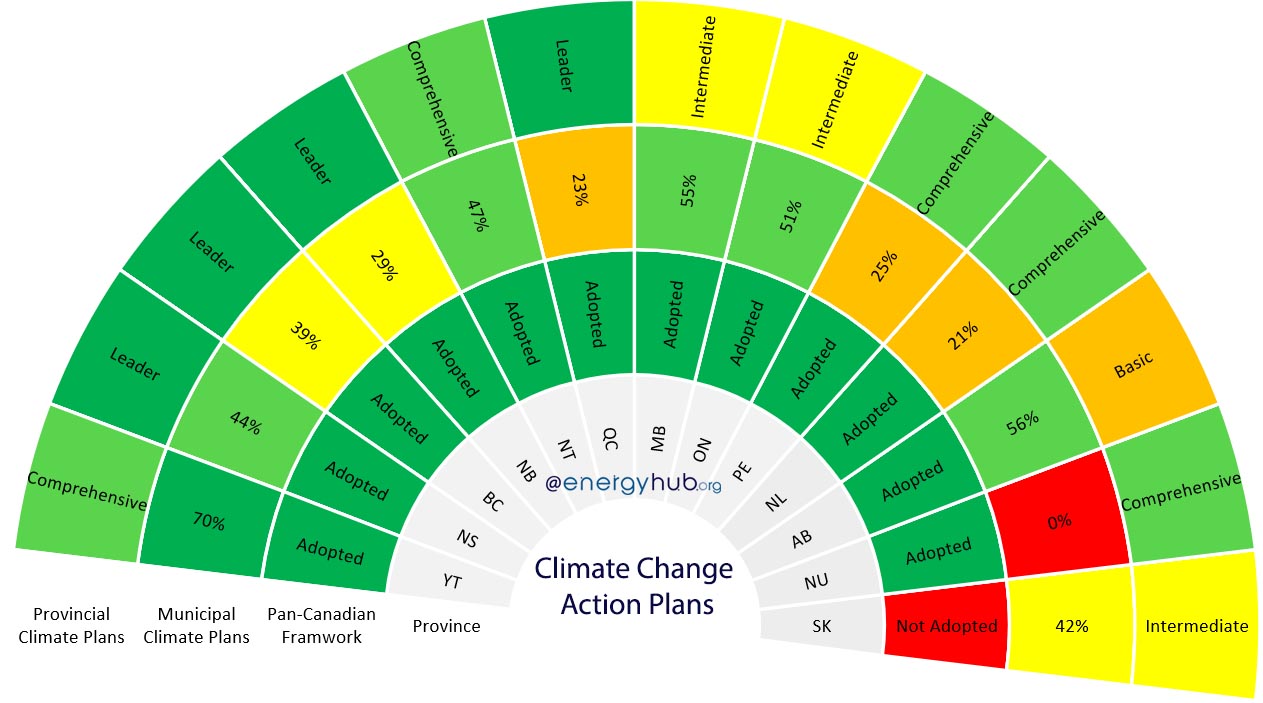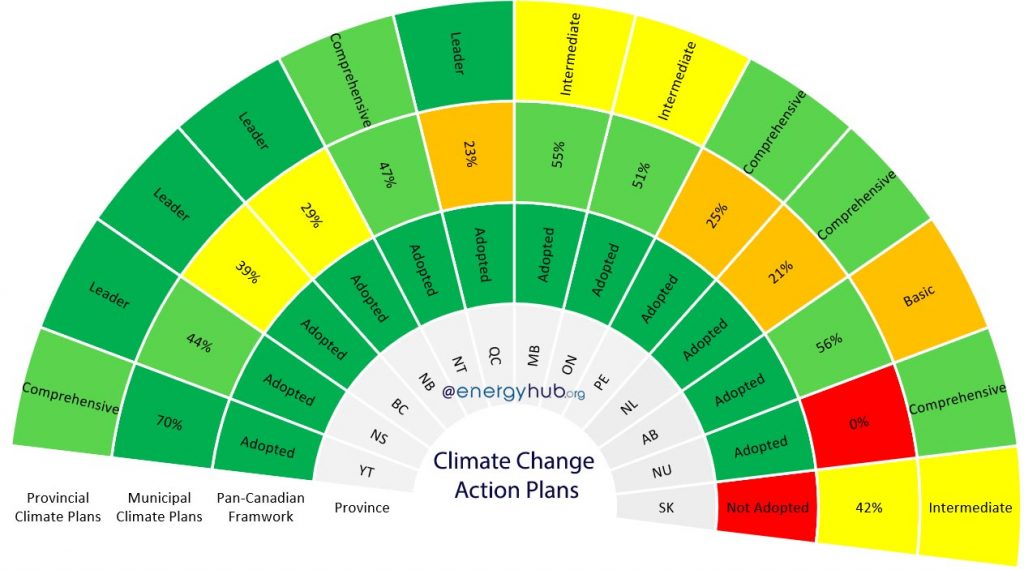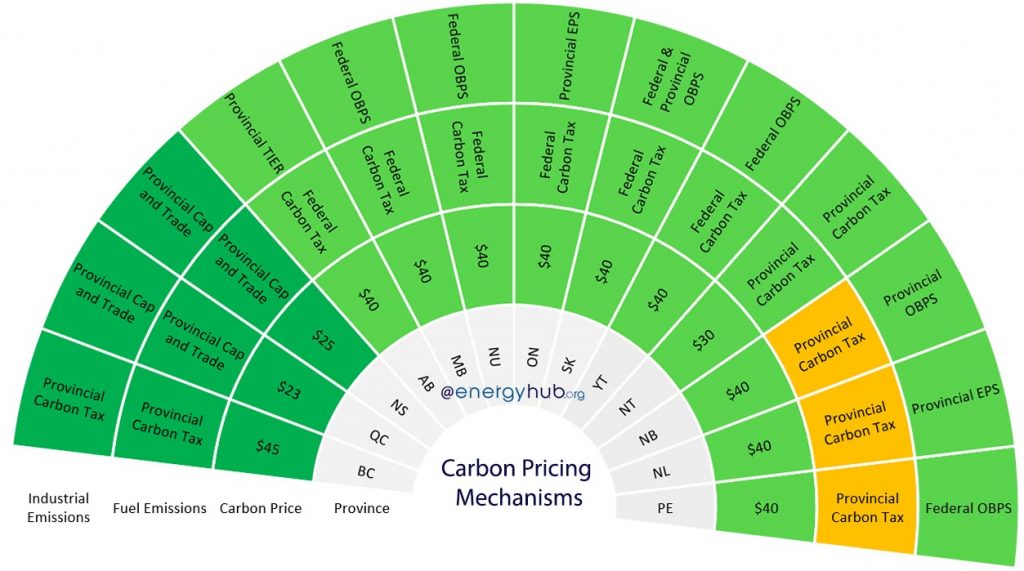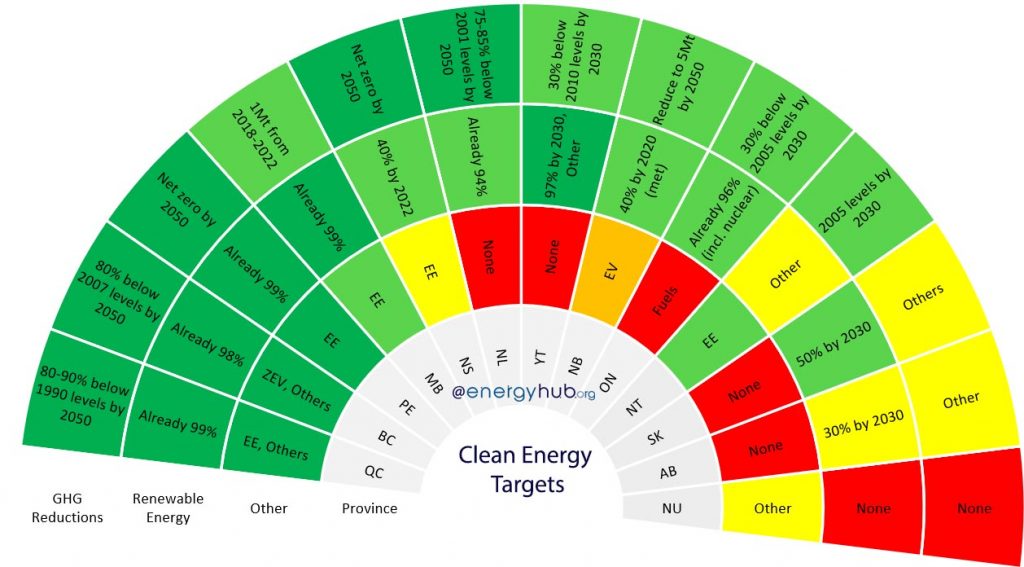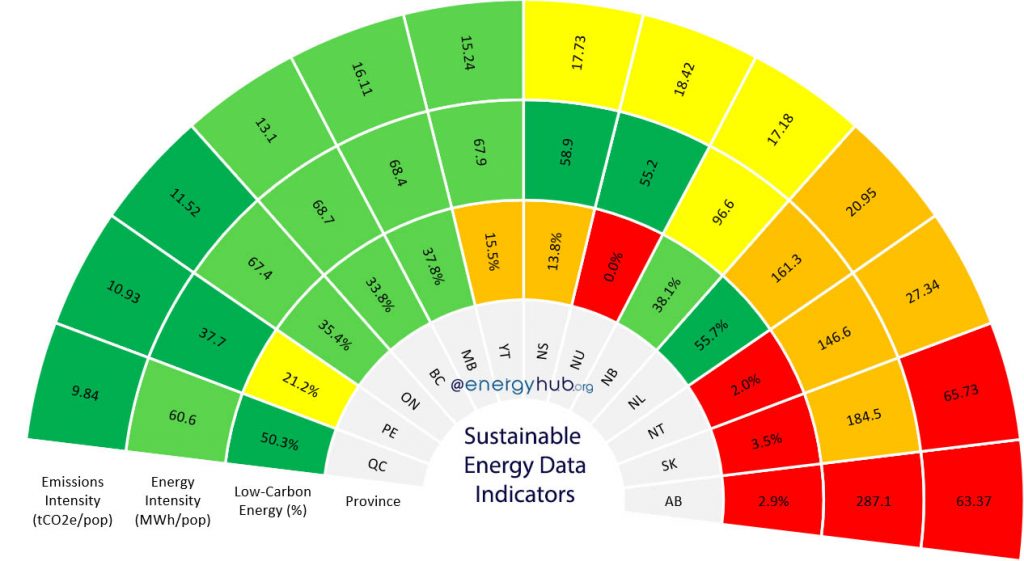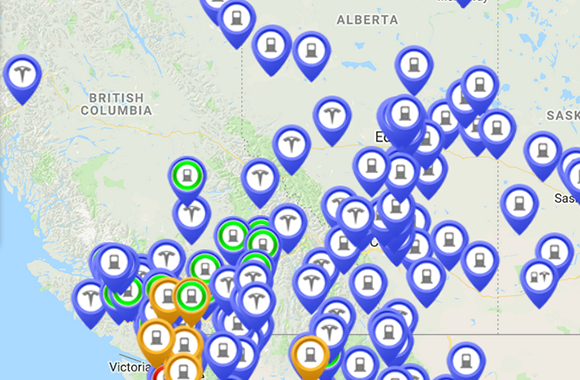Climate Action Plans & Strategies Canada 2021
Published by Rylan Urban and Chloe McElhone on April 22, 2021.
There are at least 52 provincial and municipal climate action plans across Canada. This total includes all plans and strategies for climate change action, adaptation, and resilience – as well as clean energy and emission reduction strategies.
Climate change action plans on this page are sorted by province and territory. Start your search by clicking on you jurisdiction below:
Canada-Wide Climate Change Action Plans

The Government of Canada’s first ever national climate strategy is the 2016 Pan-Canadian Framework on Clean Growth and Climate Change. This document serves as Canada’s plan for reducing emissions, growing the economy, and building a country that is resilient to climate change.
The Pan-Canadian Framework was co-published along with every province and territory, except Manitoba and Saskatchewan. While Manitoba later joined the Pan-Canadian Framework in 2018, Saskatchewan remains the only jurisdiction in Canada yet to sign.
In December 2020, the Government of Canada published a strengthened climate plan, A Healthy Environment and a Healthy Economy. This document builds on the Pan Canadian Framework putting Canada on path to exceed its Paris-aligned 2030 emissions reduction targets.
Provincial Climate Change Action Plans
Alberta

The Government of Alberta’s climate strategy is outlined in their report titled, Alberta’s Climate Leadership Plan: Progressive Climate Policy. This document serves as Alberta’s plan to reduce emissions, diversify their economy, create jobs, and protect their health and environment.
Alberta’s Climate Leadership plan was originally published in November 2015 and was most recently updated in June 2018. You can read more about climate change in Alberta on their website.
Municipal Climate & Energy Plans
In Alberta, approximately 56% of the population is covered under a municipal climate change action plan.
Calgary
- Calgary Climate Resilience Strategy – Calgary’s climate strategy was published in 2018 and focuses on both climate change mitigation and adaptation. It plans to reduce city-wide emissions below 2005 levels by 2050.
Canmore
- Canmore Climate Action Plan – Canmore published its climate strategy in 2020, with the goal to reduce emissions below 2005 levels by 30% by 2030 and 80% by 2050.
- Canmore Climate Change Adaptation & Resilience Plan – Canmore’s adaptation plan was published in 2016 and outlines how the municipality will tackle the effects of climate change.
Edmonton
- Edmonton Climate Change Adaptation & Resilience Strategy – Edmonton’s climate strategy was originally published in 2018 and focuses on the impacts of climate change while protecting Edmonton’s community, infrastructure and services. You can learn more on their program website, Change for Climate.
- Edmonton Community Energy Transition Strategy – Edmonton’s most recent community energy strategy was published in 2020, building on ambitious plans to limit the rise of global average temperature to 1.5 degrees Celsius.
Red Deer
- Red Deer Climate Change Adaptation Plan – Red Deer published Part 1 of their climate strategy in 2014 which outlined its overall climate goals. Part 2 is currently being developed and will include more detailed goals for each action theme.
- Red Deer 2019 Environmental Master Plan – Red Deer incorporated its Energy Plan into their Environmental Master Plan in 2019, with the target to have 25% renewable electricity by 2035.
British Columbia

The Government of British Columbia has a comprehensive climate strategy called CleanBC. The plan was first released in 2018, and puts the province on path to a cleaner, better future built around a low carbon economy.
The CleanBC website is the easiest way to learn about the plan, along with its targets, ambitions, and incentives for homes and businesses. You can also find the CleanBC budget update and BC’s 2020 Climate Change Accountability Report on the site.
Municipal Climate & Energy Plans
In British Columbia, approximately 39% of the population is covered under a municipal climate change action plan.
Kamloops
- Kamloops Community Climate Action Plan – Kamloops is currently finalizing their climate strategy and should be published in summer 2021. Its proposal is to implement 8 “Big Moves”, including having 85% zero-emissions vehicles by 2050, 100% zero-emissions heating and hot water systems by 2030, and becoming a circular economy by 2040.
- Kamloops Corporate Energy and Emissions Management Plan – Kamloops’ 2013 energy plan has 5 main objectives, including using carbon neutral energy at all City facilities by 2035 and being building energy self-sufficient by 2050.
Kelowna
- Kelowna Climate Action Plan – In 2018, Kelowna published its climate plan with the targets to reduce emissions 4% below 2007 levels by 2023, 25% by 2033, and 80% by 2050. You can read more about climate action in Kelowna on their website.
- Kelowna Corporate Energy and GHG Emissions Plan – Kelowna’s 2018 energy plan outlines a framework to encourage energy reduction across the community. Rather than set specific targets, it makes recommendations on programs and incentives that will push renewable energy use and decrease emissions in energy to meet their climate goals.
Nelson
- Nelson Climate Change Action Plan – Nelson’s climate plan was published in 2020 with a focus on building resilience and having net zero municipal operations by 2030. It also has two targets to reduce community GHG emissions by 2030 and be net zero by 2040.
Prince George
- Prince George Climate Change Mitigation Plan – Prince George’s climate strategy was published in 2020 and focuses on 6 areas for improvement: transportation, land use, buildings, waste management, renewable energy, and policy, decision-making, and reporting. It sets the goal of reducing GHG emissions by 80% by 2050.
Richmond
- Richmond Community Energy & Emissions Plan – Richmond published its plan in 2014 with the target to reduce GHG emissions by 80% below 2007 levels by 2050.
Surrey
- Surrey Climate Change Action Strategy – Surrey’s new climate strategy is in its preliminary phases and should be finalized and published by the end of 2021. Its two main goals are to achieve net zero community wide GHG emissions before 2050 and absolute zero corporate GHG emissions before 2050. It will incorporate Surrey’s already existing Community Energy and Emissions Plan (2013), Climate Adaptation Strategy (2013), and Corporate Emissions Action Plan (2010).
- Surrey Community Energy & Emissions Plan – Surrey’s energy plan was published in 2013 with the goal of reducing GHG emissions by 47% below 2007 level per capita by 2040. At the end of 2021, this energy plan will be incorporated into Surrey’s new Climate Change Action Plan.
Vancouver
- Vancouver Climate Change Adaptation Strategy – Vancouver’s climate adaptation strategy focuses on ensuring the city’s preparedness for the changing climate. While initially published in 2012, it was updated in 2018 to reflect new changes in climate science.
- Vancouver Climate Emergency Action Plan – Vancouver’s climate strategy was approved in 2020, which puts the city on track to reach its emissions reduction goal of 50% by 2030. It is based on three pillars: how we move (transportation), how we build and renovate (construction), and how we capture carbon.
- Vancouver Neighbourhood Energy Strategy – Vancouver’s energy strategy aims to develop neighbourhood renewable energy systems with the goal to meet 100% of the city’s energy needs from renewable sources before 2050.
Vernon
- Vernon Climate Action Plan – Vernon published its original climate plan in 2011, but has updated in 2021. It aims to increase resilience and become net zero by 2050.
Victoria
- Victoria Climate Leadership Plan – Victoria published its climate strategy in 2018 and subsequently declared a climate emergency in March 2019. Their plan is to reach an 80% reduction in emissions and transition to 100% renewable energy by 2050.
Manitoba

The Government of Manitoba’s climate strategy is outlined in the Made-in-Manitoba Climate and Green Plan. The plan was published in 2017 and aims to make Manitoba the cleanest, greenest, and most climate resilient province in Canada.
You can read more about climate change in Manitoba on their website.
Municipal Climate & Energy Plans
In Manitoba, approximately 55% of the population is covered under a municipal climate change action plan.
Churchill
- Churchill Climate Change Adaptation Strategy– The municipality of Churchill published its climate strategy in 2020. Its major objectives are to establish a new future direction based on the most up to date climate data and to engage with stakeholders for action and adaptation recommendations.
Winnipeg
- Winnipeg Climate Action Plan – Winnipeg published its climate plan in 2018. Its targets are to reduce GHG emissions 20% below 2011 by 2030 and 80% by 2050.
New Brunswick

The Government of New Brunswick’s climate strategy is outlined in their Climate Change Action Plan. The plan was originally published in 2016, aiming to reduce GHG emissions while promoting economic growth and increasing resilience to climate change.
Municipal Climate & Energy Plans
In New Brunswick, approximately 29% of the population is covered under a municipal climate change action plan.
Edmundston
- Edmundston Climate Change Adaptation Plan – Edmundston adopted a new climate plan in 2020, but it is not currently released to the public.
Fredericton
- Fredericton Climate Change Adaptation Plan – Fredericton published its plan to focus on adaptation strategies over the years 2020 to 2025. It has 6 main goals, including strengthening the resilience of core municipal infrastructure and maintaining health and safety.
- Fredericton Community Energy & Emissions Plan – Fredericton is in the process of creating an energy and emissions plan, focusing on the reduction of electricity and natural gas use.
Moncton
- Moncton Climate Change Adaptation & Flood Management Strategy – Moncton’s adaptation plan was developed in 2013 in order to identify and prepare climate change adaptation strategies and actions to increase the adaptive capacity of the city.
- Moncton Corporate Energy & GHG Reduction Plan – Moncton’s most recent energy plan was published in 2016, but its targets do not go beyond 2020.
Saint John
- Saint John Climate Change Action Plans – In 2019, Saint John adopted two energy plans: one corporate and one community-based. By 2025, the goals are to reduce Corporate GHG emissions by 20% and Community GHG emissions by 9%.
Newfoundland and Labrador

The Government of Newfoundland and Labrador’s climate strategy is outlined in The Way Forward on Climate Change: 2019 Climate Change Action Plan. This plan details the province’s approach to advance climate action, reduce GHG emissions, build climate resilience, and support clean economic growth.
You can read more about Newfoundland and Labrador’s climate strategy by visiting their website, Turn Back The Tide.
Municipal Climate & Energy Plans
In Newfoundland and Labrador, approximately 21% of the population is covered under a municipal climate change action plan.
St. John’s
- Resilient St. John’s Community Climate Plan – In March 2021, St. John’s announced they are developing a climate plan that will be published in late summer 2021. It will set out a 30-year plan to reduce GHG emissions while supporting energy efficiency.
Northwest Territories

The Government of Northwest Territories’ climate strategy is outlined in its 2030 NWT Climate Change Strategic Framework. The framework outlines the NWT’s long-term comprehensive and coordinated response to climate change.
The Government of Northwest Territories has additionally released its first 2019-2023 Action Plan. The NWT’s climate strategy is also complemented by its 2030 Energy Strategy.
Municipal Climate & Energy Plans
In the Northwest Territories, approximately 47% of the population is covered under a municipal climate change action plan.
Yellowknife
- Yellowknife Corporate and Community Energy Action Plan – Yellowknife’s most recent energy plan was approved in 2014. It sets targets to reduce GHG emissions and increase renewable energy use over the years 2015 to 2025.
Nova Scotia

The Government of Nova Scotia’s comprehensive strategy to address climate change is outlined on their Climate Change website. The strategy includes several climate regulations, as well as a 2009 Climate Change Action Plan and 2010 Renewable Electricity Plan.
Nova Scotia also started Efficiency Nova Scotia in 2009 and currently provides funding to the Clean Foundation – both of which offer several programs and incentives for homes and businesses in the province.
Municipal Climate & Energy Plans
In Nova Scotia, approximately 44% of the population is covered under a municipal climate change action plan.
In 2011, the province of Nova Scotia mandated municipalities to prepare municipal climate change action plans by the end of 2013 to be eligible to receive funding from the federal gas tax.
On this page, we’ve opted to not include plans used solely to meet this requirement. Only climate plans that go above and beyond – and published since 2014 – are listed here.
Halifax
- Halifax HalifACT 2050 Plan – Halifax published its climate plan in 2020. It puts in place a wide range of climate change actions and associated targets, including GHG emissions, renewable energy, water management, and building retrofitting.
Nunavut

The Government of Nunavut’s climate strategy is outlined in Upagiaqtavut: Setting the Course Climate Change Impacts and Adaptation in Nunavut. Upagiaqtavut establishes a framework for climate change impacts and adaptation, and aims to help Nunavut better adapt to changes brought on by climate.
You can read more about about the territory’s strategy on the Nunavut Climate Change Centre website.
Ontario

The Government of Ontario’s climate strategy is outlined in their Made in Ontario Environment Plan. Plan plan aims to protect Ontario’s air, land, and water – while reducing waste, lowering emissions, and helping communities to prepare for climate change.
You can learn more about how Ontario is protecting the environment and and addressing climate change on their website.
Municipal Climate & Energy Plans
In Ontario, approximately 51% of the population is covered under a municipal climate change action plan.
Brampton
- Brampton Energy and Emissions Management Plan – Brampton’s most recent energy plan sets a strategy for 2019-2024 and builds on its successful 2014-2019 plan. Its interim target is to reduce emissions 20% below 2010 levels by 2024. This short-term goal was developed to support the city’s long term goal of reducing GHG emissions 80% by 2050.
Burlington
- Burlington Climate Action Plan – Burlington published its climate action plan in 2020 to reduce GHG emissions while increasing resilience and engagement with stakeholders. Its target is to become a net carbon neutral community by 2050. The city is also currently developing a Climate Adaptation Plan.
Hamilton
- Hamilton Community Energy and Emissions Plan – Hamilton is currently developing an energy plan that will support its target of becoming net-zero by 2050. It will set out energy and emissions projections and identify actions to reach its target.
Kingston
- Kingston Climate Leadership Plan – Kingston is in the process of developing a climate strategy to replace its 2014 Climate Action Plan. It will include climate adaptation and mitigation actions and aim to become a carbon neutral city by 2040.
London
- London Climate Emergency Action Plan – The city of London is currently developing its climate plan that will align with its goals to reduce GHG emissions 30% by 2030 and be net zero by 2050.
Mississauga
- Mississauga Climate Change Action Plan – Mississauga’s 2019 climate plan balances both mitigation and adaptation. It has a particular focus on GHG emissions from buildings, as they account for 52% of the city’s emissions. Mississauga aims to reduce emissions 40% below 1990 levels by 2030 and 80% by 2050.
- Mississauga 5-Year Energy Conservation Plan – Mississauga’s 2019-2023 energy plan builds upon the successes of its 3 previous 5-year plans. It aims to reduce energy use and GHG emissions by 1% per year for city facilities during the 5-year period.
Oakville
- Oakville Community Energy Strategy – Oakville endorsed the Oakville Energy Task Force’s energy strategy in 2020. Its goals are to reduce GHG emissions 50% below 2016 levels by 2041 and increase energy efficiency by 40% over 2016 levels by 2041.
Ottawa
- Ottawa Climate Change Master Plan – Ottawa published its climate plan in 2020 – acting as a framework for how the city will mitigate and adapt to climate change. The plan supports several incremental GHG reduction targets that conclude with a 100% reduction in community emissions below 2012 levels by 2050 and a 100% reduction in city operations’ emissions by 2040.
- Ottawa Energy Evolution: Ottawa’s Community Energy Transition Strategy – Energy Evolution is one of the 8 pillars of the city’s Climate Change Master Plan. It is a vision to transform Ottawa into a thriving city powered by clean, renewable energy.
Thunder Bay
- Thunder Bay Climate Adaptation Strategy – Thunder Bay’s 2015 strategy focuses on building resilience to the impacts of climate change while taking advantage of the associated opportunities.
- Thunder Bay Community Energy and Emissions Plan – Thunder Bay’s energy and emissions plan will be published in 2021 and will include an action plan to reduce both energy consumption and GHG emissions with a target to become carbon neutral by 2050.
Toronto
- TransformTO – TransformTO is Toronto’s climate strategy intended to mitigate and adapt to climate change, and reduce emissions to reach net zero by 2050 or sooner. Toronto is also developing a Net Zero Strategy in response to City Council declaring a climate emergency.
- Toronto Resilience Strategy – Toronto also published a strategy in 2019 that focuses in part on adaptation and resilience to climate change, including reducing the inequalities of populations who are impacted the hardest.
Vaughan
- Vaughan Community Climate Change Action Plan – Vaughan’s climate strategy was published in 2014 and sets the target to reduce community GHG emissions 20% per capita below 2006 levels by 2026.
Prince Edward Island

The Government of Prince Edward Island’s climate strategy is outlined in their most recent Climate Change Action Plan. The 5-year plan aims to provide a framework for adapting to climate change and reducing GHG emissions You can read more about the plan on their Climate Change Action Plan website.
PEI has also developed a Provincial Energy Strategy in 2017 which is a 10-year strategy to reduce energy use and to establish local and clean energy production.
Municipal Climate & Energy Plans
In PEI, approximately 25% of the population is covered under a municipal climate change action plan.
Charlottetown
- Charlottetown Community Energy Plan – Charlottetown’s 2019 community energy plan sets two major targets. First, it will transition to a 100% renewable and carbon neutral city by 2050. Second, it aims to reduce corporate GHG emissions 40% by 2030 and community GHG emissions 50-65% by 2030.
Québec

The Government of Quebec’s climate strategy is outlined in their 2030 Plan for a Green Economy. This plan is Quebec’s framework for electrification and climate change which lays the groundwork for a resilient and prosperous green economy by 2030.
Complementary to this framework, Quebec has also published The 2030 Energy Strategy: Energy in Quebec: A Source of Growth. The energy strategy aims to make Quebec a North America leader in renewable energy and energy efficiency – while building a low-carbon economy.
Municipal Climate & Energy Plans
In Quebec, approximately 23% of the population is covered under a municipal climate change action plan.
Montreal
- Montreal Climate Plan – Montreal’s 2020-2030 climate plan was published to support their goals of reducing GHG emissions by 55% by 2030 and becoming carbon neutral by 2050. It aims to achieve these targets through reducing the use of fossil fuel in buildings, reducing food waste, and accelerating sustainable transportation.
Sherbrooke
- Sherbrooke Climate Change Adaptation Plan – Sherbrooke’s climate strategy focuses on managing climate-related risks from 2013 to 2023. It supports the city’s goal of reducing its GHG emissions by 30% by 2030 compared to 2009 emissions.
Saskatchewan

The Government of Saskatchewan’s climate strategy is outlined in Prairie Resilience: A Made-in-Saskatchewan Climate Change Strategy and Climate Resilience in Saskatchewan 2020 Report. These reports outline Saskatchewan’s plan to cope with, adapt to, and recover from climate stress and change.
You can read more about climate change in Saskatchewan on their website.
Municipal Climate & Energy Plans
In Saskatchewan, approximately 42% of the population is covered under a municipal climate change action plan.
Regina
- Energy & Sustainability Framework – Regina is currently developing an energy and sustainability framework to help them meet their goal of moving towards 100% renewable energy sources by 2050.
Saskatoon
The City of Saskatoon has a comprehensive Climate Action Plan that consists of several parts:
- Local Actions: The City of Saskatoon’s Adaptation Strategy – This strategy focuses on mitigating climate risks to key infrastructure, programs, and services.
- Low Emissions: Saskatoon’s Mitigation Strategy – This strategy was published in 2019 and aims to achieve the city’s target to reduce community emissions 15% by 2023 and 80% by 2050.
- Green Infrastructure Strategy – This strategy was published in 2020 and outlines actions to achieve the city’s vision for a holistic green network that provides sustainable habitat for people and nature.
Yukon Territory

The Government of Yukon’s climate strategy is outlined in Our Clean Future: A Yukon Strategy for Climate Change, Energy and a Green Economy. The plan addresses climate impacts while striving to build a green economy and ensure access to reliable, affordable renewable energy.
You can read more about climate change in Yukon on their website.
Municipal Climate & Energy Plans
In Yukon Territory, approximately 70% of the population is covered under a municipal climate change action plan.
In 2011-2012, a collaborate initiative called the Community Climate Change Adaptation Project created climate change adaptation plans for three Yukon communities: Dawson City, Whitehorse, and Mayo. We have only included more recent plans in our list below.
Whitehorse
- Whitehorse Sustainability Plan – Whitehorse published its climate strategy in 2015 which covers a wide range of topics including GHG reductions, low-impact transportation, and livable neighbourhoods.
More Clean Energy Reference Guides
💜 Support us by sharing this page, bookmarking it for later, or referencing us online! 💜
